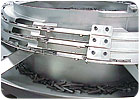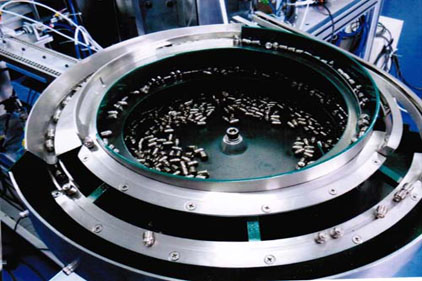
A manufacturer of safety glasses offers its products in many styles. Even so, production volumes are large, and the company assembles its glasses on an automated line.
The company wanted to automate the assembly of arm hinges for different styles of safety glasses. The hinges ranged in length from 0.625 to 2 inches long. The parts differed in both width and height. Fortville Feeders Inc. was contracted to design and build a feeder system that would feed each of five arm sizes at a rate of 120 parts per minute.
Fortville Feeders designed a custom 27-inch vibratory feeder bowl. The bowl was equipped with three orientation tracks that converge into a single in-line discharge. The company also provided a mounting plate with legs, isolation feet, a sound enclosure, and a supply hopper with a capacity of 1 cubic foot.
According to Tim Butts, vice president of business development at Fortville Feeders, several features were critical to the success of this feeder system:
* bolt-on, quick-change orientation devices and selectors for rapid changeover.
* lift-off or hinged sound enclosure doors and panels, which provide unobstructed access to bowl tooling.
* a capped-off return pan to reduce part cross-contamination.
* an easy-access, quick-dump feature, allowing for rapid part removal during changeover.
* a bowl large enough to allow the parts to move up tracks with minimum pitch.
For more information on parts feeders, call Fortville at 317-485-5195 or visitwww.fortvillefeeders.com.
Editor’s note: “We Fed It” is a regular series profiling parts feeders for automated assembly. Whether it’s a vibratory bowl, a tray feeder or a flexible robotic system, if you’ve solved a parts-feeding challenge, we’d like to hear about it. Send an e-mail to John Sprovieri, editor of ASSEMBLY, at sprovierij@bnpmedia.com, or call 630-694-4012.




